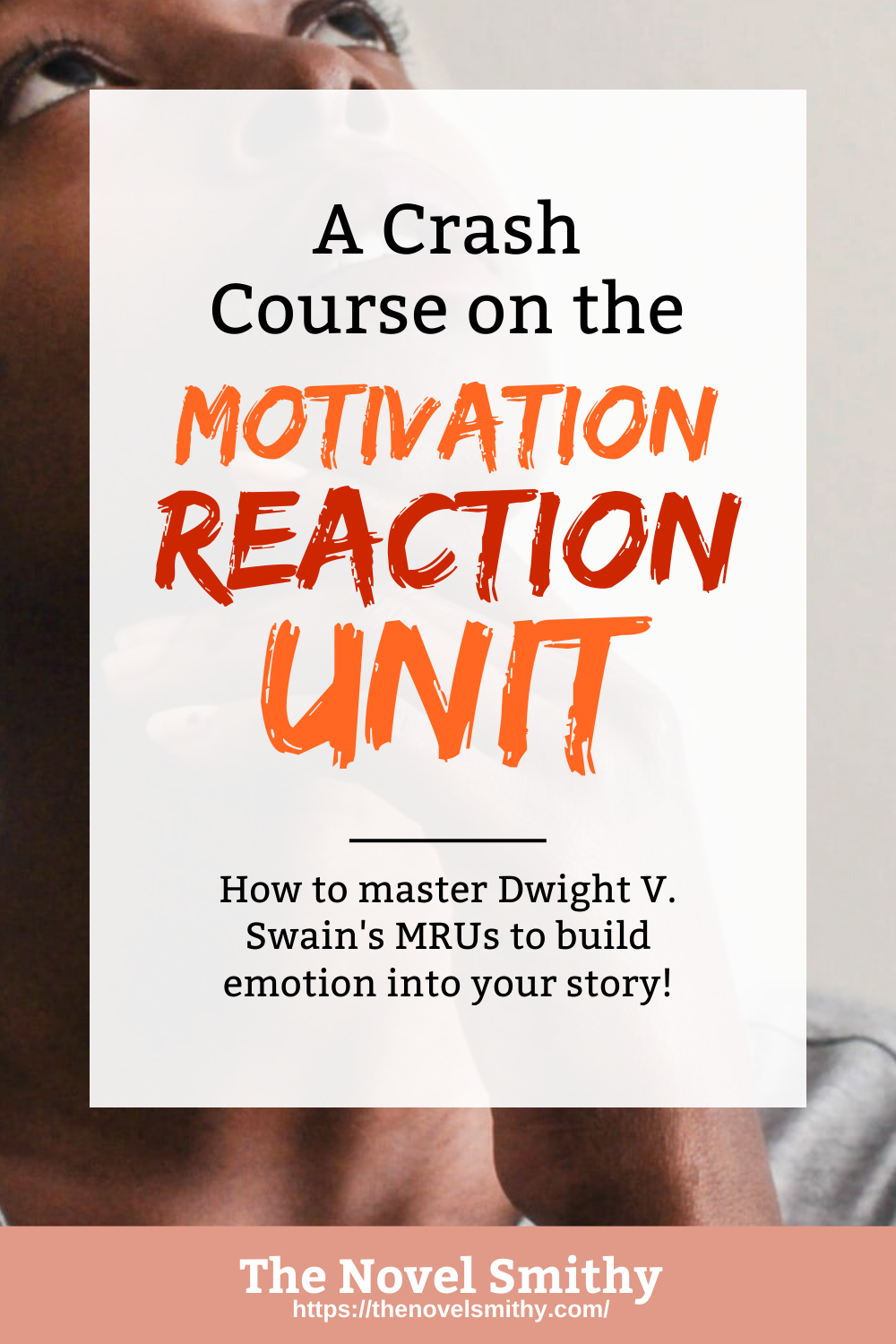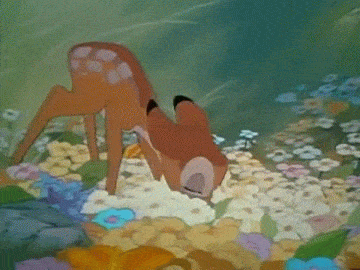A Crash Course on the Motivation-Reaction Unit
As writers, our goal is to create stories that feel real.
Naturally, this is easier said than done. Despite our best efforts, our novels will always be collections of words on paper, rather than actual events happening to our readers. Yet, plenty of novels still feel real despite this—and that is thanks to the motivation-reaction unit.
Though the name may sound intimidating, motivation-reaction units are a simple formula writers can use to craft prose that feels visceral and alive for our readers. So, let me walk you through the two halves of the motivation-reaction unit, along with a few things you’ll need to remember when writing MRUs of your own!
What is the Motivation-Reaction Unit?
Contents
 Motivation-reaction units (or MRUs) are the building blocks of well-written prose, forming a clear chain of cause and effect that drives all of our characters’ actions. Ingrid catches her fingers in the car door, and yelps in pain—that is a motivation-reaction unit.
Motivation-reaction units (or MRUs) are the building blocks of well-written prose, forming a clear chain of cause and effect that drives all of our characters’ actions. Ingrid catches her fingers in the car door, and yelps in pain—that is a motivation-reaction unit.
This writing technique was originally created by Dwight V. Swain in his book, Techniques of the Selling Writer. In it, he describes MRUs like this:
“Someone pulls a gun; you stop short. A girl casts a sidewise glance; you start forward. The clock strikes; you get up… Each time, one motivating stimulus; one character reaction.
Together, they constitute a motivation-reaction unit. Each unit indicates some change, however small—change in state of affairs; change in state of mind.” – Dwight V. Swain, Techniques of the Selling Writer
This is a useful principle, one that can strengthen your writing in a few ways.
For starters, MRUs keep readers grounded, ensuring the who, what, when, where, and why of your novel are clear. Meanwhile, they also help readers immerse themselves in your story. We process the world around us by first experiencing some motivation, and then reacting to that experience—and thus we want our characters to as well.
This is where we can take a closer look at the MRU’s two halves.
The 2 Halves of the Motivation-Reaction Unit
Motivation – External Stimuli:
To start things off, the first half of the motivation-reaction unit is motivation. This is any external stimuli that triggers a reaction from your character.
That word “external” is particularly important here. To work as your POV character’s motivation, this event needs to be some outside force. Typically, this is tied to our five senses, such as smelling a delicious meal or seeing a pack of wolves. However, it is possible that your character’s thought or memories trigger their reaction. Though this isn’t technically external to your character, it fulfills the same basic role.
Of course, not all motivations are created equal.
Ideally, you want the motivation to have a direct impact on your character, reader, or plot—if not all three. For example:

“The car screeched to a stop, inches from where she stood in the dimly lit parking lot.”
In this example, the near-miss by the speeding car is our motivation, which has a clear link to our POV character because it creates immediate danger. Best of all, it also sets us up for a whole slew of potential reactions!
This is the final thing you’ll want to remember about the motivation—it will ALWAYS come before the reaction. After all, to react to an event, your characters (and thus your readers) need to experience it first.
Reaction – Internal Emotion:
Next we have the reaction, which is the internal, subjective response your character has as a result of the motivation. This occurs in four stages:
- Emotion
- Reflex
- Action
- Dialogue
Often, you’ll use all four of these in sequence, but sometimes you’ll only need a handful to make your point—how many you include in each reaction is up to you. For example, here’s a continuation of our MRU from earlier, featuring all four responses:
“The car screeched to a stop, inches from where she stood in the dimly lit parking lot. Fear swept through Fusako’s heart (emotion) as she flinched away (reflex). It took all of her willpower to hold her ground (action). ‘Not today,’ she whispered (dialogue).”
Regardless of how many reactions you use, you should always use them in order.
Emotion comes first, because it’s a knee-jerk, automatic response to external stimuli. Then, you’ll have a physical reflex, such as your heart jumping or your hand flying to your chest. Next, you’ll make some choice, however subtle, that takes the form of a specific action. And finally, you might translate that action into speech, depending on the situation at hand.
Basically, as you write the reaction, you’ll want to slowly progress from subconscious, involuntary reactions to conscious, purposeful actions.
6 Things to Remember When Writing MRUs
Experiment With Length:
With those two halves, you have basically everything you need to write a motivation-reaction unit of your own. Still, there are a few things you’ll want to keep in mind that should make writing MRUs easier.
First up, you might assume all motivation-reaction units are a single paragraph—which makes sense, considering all the examples we’ve used so far have been pretty short. However, this actually isn’t true.
Instead, MRUs can be as long or as short as you want!
Usually, you’ll want your motivation to be a separate paragraph from your reaction, at least where possible. That motivation could be two or even three paragraphs long, while the reaction could include multiple paragraphs of reflection and subsequent action. This makes MRUs very flexible, allowing them to apply no matter what’s going on in your story.
For instance, Jack falling and Jill whirling around to pull him to safety can work as a motivation-reaction unit—while Jill sitting up that night and reliving the experience in her head can also work just as well.
Consider Personality:
Next, when writing motivation-reaction units, you need to keep personality in mind.
Just as your characters have their own character arcs, goals, wants, and needs, they’ll also have distinct personalities that dictate how they respond to events. A fearful, shy character might instinctively cower when someone yells at them, while an aggressive, short-tempered character would fly into a rage.
Either way, your character’s reaction should match their personality.
This goes both ways too. Every character in your novel is reacting to the events around them just like your POV character, and thus one character’s reaction will often act as the motivation for another member of your cast—creating a nice chain of cause and effect!
Incorporate Descriptions:
At first glance, perhaps the hardest part of writing an MRU is finding time to set the scene.
Most of us associate the word motivation with action, or some other big event that sparks a significant change in our characters. However, locations, weather, sights, and sounds can all play the role of the motivation too!
This is how you can incorporate descriptions into your motivation-reaction units.
The best way to think of this is as if you were a movie camera. When you first enter a scene, you’ll be zoomed out, giving you a chance to show the trees and the mountains in the distance. Then, you would move closer, focusing on the dusting of snow on the ground and dried leaves poking out above the surface. Finally, you’d reach your character, watching as a deer moves gently through the underbrush.

In this example, that deer (and the forest around them) act as the motivation for our protagonist—as well as a great way to illustrate their desires. Perhaps they’re starving, and are thus calculating exactly how to reach the deer and kill it before it runs away. Or maybe they’re on a peaceful hike, and are instead observing the beauty of nature.
Depending on their goals and needs, the way they react to your setting will change—thus acting as both a great motivation, and an easy way to say something about who they are as a character.
Don’t Break the Flow:
Alongside incorporating descriptions into your MRUs, another important thing to remember is not to break the chain.
Whenever possible, your motivation-reaction units should flow one after the other.
For instance, Hakim’s teacher hands him his exam and he sees the “F” emblazoned in red ink on the front (motivation). Distraught, he drops his heads into his hands and fights to hold back tears, sure he’ll be held back just like his mother warned him (reaction). Luckily, his friend Sara pats his shoulder and whispers that she’ll help him study for the retest (motivation). Relieved, Hakim sighs, before turning to smile gratefully at Sara (reaction).
From there, the story would continue to unfold, one MRU after another, thus creating a steady flow of cause and effect. While you may have some spots where that chain is disrupted, you’ll want to avoid them as much as possible.
“…your copy should leave the impression of a continuing stream of reality, in which effect follows cause like a burnt finger jerking back from a hot stove. Even if the reaction is merely to stare numbly, it should start now, not five minutes after the stimulus to shock is past and gone… If it does, odds are that you’ve broken the flow…” – Dwight V. Swain, Techniques of the Selling Writer
Save MRUs for Later Drafts:
The motivation-reaction unit is a fantastic writing tool—but it also has a time and place.
While you might feel pressured to put the MRU to work as soon as you start writing your first draft, I encourage you not to. You already have a lot to think about early in the writing process, from your plot to your story’s structure, pacing, and characters. Adding a whole extra element on top of that just isn’t necessary, especially when you’ll likely rewrite a lot of your novel’s prose while editing.
Instead, MRUs are best for later drafts.
Rather than worry about writing perfect motivation-reaction units during your first draft, save that for your third or even fourth draft. This way, your plot and characters will be in a good place, and you can shift all of your focus to your prose itself—comfortable in the knowledge that you won’t have to redo all this work later.
Ignore the Rules on Occasion:
Finally, every novel is unique, meaning this might not work for every part of your story.
While I recommend sticking to the MRU formula as much as possible, there are definitely instances where you can ignore it, either for the sake of your prose or your plot. Above all, the most important thing is ensuring your novel is clear, and that readers can easily keep up with what’s happening on the page. If a certain motivation-reaction unit jeopardizes that, then it’s ok to explore other options.
MRUs vs Scene Structure
With all that said, there is one more topic we need to discuss before wrapping up this article—and that is the difference between motivation-reaction units and scene structure. This was actually requested by a long-time reader of The Novel Smithy, who emailed me to ask:
“I think I’m confusing parts of the Action-Reaction (scene structure) with MRUs maybe. Are these the same? Or are there multiple MRUs in all 6 parts of the scene?”
My response went something like this:
“I think you’re confusing two different ‘levels’ of your story. Swain’s motivation-reaction unit is more focused on the prose of your story, while scene structure is a bit higher level. So, for example, in a paragraph you would first describe the external motivation affecting your protagonist, and then follow that up with their reaction to that stimuli.”
Basically, scene structure is much like the Three Act Structure, in that it focuses on the big picture plot of your scenes. Within this structure, you’ll have six stages, split between an Action and a Reaction phase:
- Goal: Your character is pursuing a goal.
- Conflict: They face conflict while trying to reach that goal.
- Outcome: There’s an outcome, either positive or negative.
- Reaction: Your character reacts to the previous outcome.
- Reflection: They reflect on their options going forward.
- Decision: They make a decision, forming a new goal and beginning the cycle again.
Obviously, a lot of these have some overlap with MRUs, but the two are not the same.
The motivation-reaction unit is all about how you structure your prose in order to keep readers grounded in your novel. Meanwhile, story structure is how you organize the events of your plot in each individual scene. The scenes of your story will contain multiple MRUs, while your MRUs won’t affect your plot itself—just how you convey that plot to others.
If you’d like to learn more about scene structure, check out this article: The Basics of Scene Structure: Action and Reaction
It’s All about Cause and Effect!
Ultimately, MRUs continue the trend of writing terms and definitions being extremely confusing. Everyone uses them slightly differently, multiple words mean the same thing, and some words—like my arch-nemesis, scene and sequel, also courtesy of Dwight V. Swain—don’t even mean what they sound like…
Still, I hope this article cleared up some of that confusion for you!
While the motivation-reaction unit might sound complex at first, it’s actually a fairly straightforward writing technique, all about crafting a clear chain of cause and effect through your prose. By making the most of the motivations and reactions that occur throughout your story, you’ll be able to create an adventure that feels visceral and natural to your readers.
After all, if we want our novels to feel real, we need to use all the tools at our disposal! 🙂


Thank you once again for such clarity in your teaching. This cleared up many of my concerns.
Glad I could help Wendy! 🙂